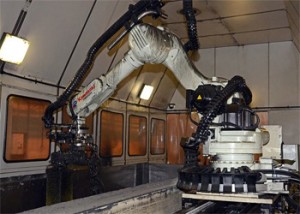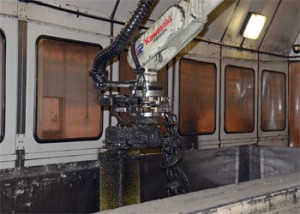Robot cleans up ash in aggressive environment
 Getting down and dirty in ash is one process that personnel at H+H UK, Goole, are pleased to leave to a new Kawasaki industrial robot. Manufacturing its market leading Aircrete Building Blocks from a mixture of pulverised fuel ash (PFA), cement and lime creates an aggressive environment for clean-up operations.
Getting down and dirty in ash is one process that personnel at H+H UK, Goole, are pleased to leave to a new Kawasaki industrial robot. Manufacturing its market leading Aircrete Building Blocks from a mixture of pulverised fuel ash (PFA), cement and lime creates an aggressive environment for clean-up operations.
The H+H factory in Goole was commissioned by Hess in 2001 and incorporated a Kawasaki JS30 robot dating from the mid 1990s originally installed at an H+H facility in the Netherlands. The new Kawasaki RS80N robot is a ‘swap out’ to replace the original Kawasaki JS30 mould cleaning robot.
The operation requires the robot to remove all ‘slurry’ residue from a mould, 6m long by 1.2m wide by 700mm deep, before it proceeds back to the moulding operation where a new slurry mix is poured. At this stage the slurry is beginning to set and is particularly abrasive. The process also requires the spraying of oil to the sides of the mould as a release agent and to help convert any residue to a mixable consistency. Powered, rotating brushes are passed over the entire surface of the mould to agitate the residue and oil mix providing a clean and even coating over the surface.
Installed within a fully enclosed spray booth, the Kawasaki RS80N robot is mounted on an 8m linear axis which follows the length of the mould. The robot has a selection of two different powered brushes, one for the base and one for the sides of the mould, which it automatically changes during the process. A spray head mounted to the robot arm allows oil to be sprayed to the sides and base of the mould during the process.
David Lazenby, Systems Support Engineer, H+H, explains: “The system has evolved, since originally being engineered, into a 60kg payload requirement; the addition of a more efficient tool change mechanism several years ago contributed to a payload of 30kg over the robots specified maximum. Regardless of this the robot operated on site without fault for 12 years until just before the swap out.
 “The new robot is specified well within requirement as it has a payload capacity of 80kg,” he continues. “The process can be completed in three minutes but the process demand allows it to operate at a comfortable 4.5 minutes. During the robot installation the operation was carried out manually taking one man ten minutes and two men six minutes.”
“The new robot is specified well within requirement as it has a payload capacity of 80kg,” he continues. “The process can be completed in three minutes but the process demand allows it to operate at a comfortable 4.5 minutes. During the robot installation the operation was carried out manually taking one man ten minutes and two men six minutes.”
The process is very aggressive with the mixture of oil spray and abrasive paste contained within the enclosure. Lazenby explains that to maintain production the robot operates continuously: “The Kawasaki robot’s design is ideal for this application; all wrist motors are enclosed and IP67 rated. The robot is cleaned weekly as part of our preventative maintenance and cleaning routines but other than this requires minimal intervention.”
Operator and maintenance interface with the system has been improved with the addition of the Kawasaki E-Series robot controller which has allowed more flexible and easier programming. Sub-routine pages have now been created for every production and maintenance situation allowing straight-forward unplanned intervention and recovery for engineers and operators without programming skills.
Summarising, Lazenby says: “The new robot is more sophisticated than the previous robot and in particular allows more control options; however our system is relatively straight-forward and does exactly what we want without unnecessary complications being introduced. The fact it can just be left to do the job without clean-down is an important element reducing the requirement for needless downtime and additional maintenance operations.”
Visit the Kawasaki website for more information.
See all stories for Kawasaki Robotics















